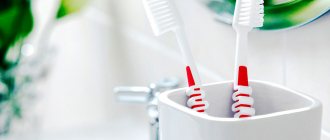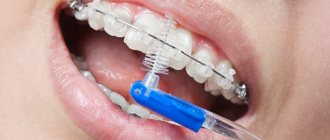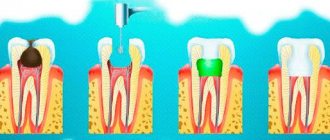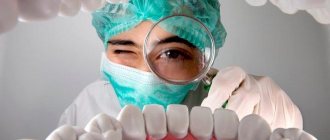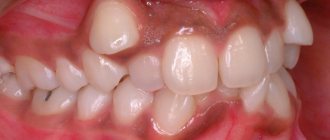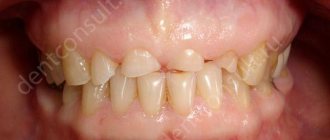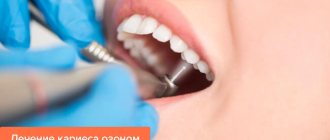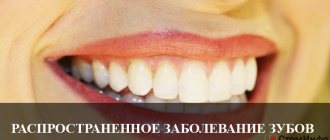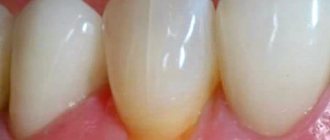Degrees of tooth mobility
To determine tooth mobility, there are several classifications in medicine:
- 1st degree. There is an unstable position of some teeth in relation to adjacent canines or molars. The amplitude of their swinging at this stage is no more than 1 mm.
- 2nd degree. The mobility of the teeth is slightly more than 1 mm, they wobble back and forth, left and right.
- 3rd degree. You can loosen your teeth in any direction, even vertically.
- 4th degree. At the last stage, rotation of the tooth around its axis is observed.
Prohibited actions and diagnostics
Typically, patients consult a doctor about tooth mobility when it reaches the 3rd or 4th stage. If its cause is periodontal disease, this means that 5-6 years have passed since the onset of the disease.
Typically, periodontal disease begins with bleeding gums that appear after brushing your teeth. It is at this moment that you should consult a doctor to prevent the development of the disease.
Late treatment makes the prognosis uncertain. It is possible that proper treatment will help avoid extraction, but this is not guaranteed.
Having discovered that a tooth is loose, the patient should do the following:
- Rinse your mouth with warm water.
- Avoid any physical impact on the problematic tooth - do not touch it with a brush when cleaning, do not touch it with your hands or tongue.
- See a doctor as soon as possible.
The doctor determines the degree of mobility and the cause of it by examining the oral cavity, and, if necessary, using fluoroscopy.
If there is significant mobility, it is easy to establish by rocking the tooth with tweezers or a finger placed on the top. The condition of the surrounding tissue is also determined by inspection and palpation.
Bright red gum color may indicate gingivitis. Gray color usually indicates its transition to the ulcerative-necrotic stage. A dark red-burgundy shade speaks in favor of periodontal disease.
This usually results in gum pockets. The doctor measures their depth and assesses the condition of the gum edge. The appearance of pockets may be accompanied by destruction of bone tissue.
Diagnosis is carried out not only with the mouth open, but also with the mouth closed - to check occlusion, determine the nature and depth of the bite. This is necessary to determine whether there is an anomaly in the structure and position of the teeth, which may cause mobility.
Main causes of pathology
Dentists correct the first two degrees of this anomaly with a long course of treatment. In the third stage, unfortunately, the teeth cannot be saved; they are removed. They begin to wobble for a variety of reasons, which must be eliminated in order to prevent the removal of molars and fangs.
Tooth mobility occurs due to the following problems:
- Incorrect bite. This pathology provokes loosening of the molars, since the position of the upper and lower jaws is disturbed.
- Periodontitis. With this disease, destruction and loss of periodontal tissue occurs. Periodontitis is highly treatable, but is a fairly common pathology.
- Gingivitis, which spreads to the bone and ligaments.
- External influence.
- Poor oral hygiene, which causes the development of many diseases.
The dentist’s main goal is to identify the cause that provoked tooth mobility, and then prescribe effective therapy. But this task is often complicated by advanced periodontitis and bone loss.
After tooth extraction, irreversible changes occur in the bone tissue, causing its partial or complete loss. When a moving tooth is removed, the bone stops receiving load, so the tissue slowly dissolves. All this leads to the fact that neighboring molars also begin to wobble.
To avoid such consequences, experts recommend installing a crown and an artificial root. This design will last for many years, and it is very similar to a natural tooth.
Causes of the disease
The level of mobility is diagnosed during an examination by a dentist, who simultaneously finds out the cause of the disease. Provided that the socket and periodontium are preserved, after eliminating the cause, tooth mobility can be eliminated.
The reasons for the development of periodontal diseases may be the following:
- bactericidal saliva;
- iatrogenic factor;
- periodontal overload;
- periodontal underload.
Factors that contribute to the development of periodontitis, periodontitis and other diseases:
- avitaminosis;
- vascular atherosclerosis;
- body reactivity;
- diseases of the gastrointestinal tract;
- pathological blood processes;
- psychosomatics.
What is forbidden to do with such an illness?
Do not loosen the tooth with your tongue or fingers. You shouldn’t touch it at all, otherwise you can worsen the situation, which will lead to negative consequences. You should rinse your mouth with warm water; it is better to avoid brushing your teeth with a brush and toothpaste for a while. If a tooth does fall out, immediately go to the dentist for emergency implantation. If this process is delayed, there will be no opportunity to qualitatively restore the tooth.
Even in such a situation, it should be remembered that fragments of a fallen fang or molar may remain inside the gums. If nothing is done, there is a high probability of complications occurring.
Diagnostic measures for loose teeth
Periodontitis can be successfully treated in the early stages, but most people with this problem are in no hurry to see a doctor. Only with strong movement of teeth and exposure of bone tissue do patients decide to visit a dental clinic. But advanced disease leads to serious damage to periodontal tissue, causing loose gums. You will need to undergo a long course of therapy, strictly following all the dentist’s recommendations in order to correct the situation.
In too severe cases, restoration of atrophied bone tissue or splinting of teeth is carried out. The determination of tooth mobility is carried out by a dentist; to make an accurate diagnosis, he sends the patient for radiography to examine bone tissue, identify purulent cavities, for example, gumboil or cysts, as well as tumors. If necessary, he can conduct additional examination using a radiovisiograph.
Methods and rules of treatment
The initial stages of periodontal disease can be successfully treated, but many patients are in no hurry to see the dentist. Only with severe exposure of bone tissue and noticeable swaying of units do people finally cross the threshold of a dental clinic.
Unfortunately, the disease at the middle/late stage causes serious destruction of periodontal tissue and provokes loose gums. Long-term treatment requires attention from the patient and strict adherence to recommendations. In severe cases, it is impossible to do without splinting teeth or surgery to restore atrophied bone tissue.
To make a diagnosis, the doctor will order an x-ray to look at the condition of the bone tissue and detect the presence of neoplasms, purulent cavities, for example, cysts or gumboil. Sometimes additional examination using a radiovisiograph is required.
General therapy
Dentists' recommendations:
- do not skip hygiene procedures;
- clean your teeth, mucous membranes, and tongue with high-quality toothpaste with fluoride, calcium, and herbal extracts;
- use local antibacterial compounds prescribed by your dentist;
- adjust your diet;
- stop drinking alcohol and cigarettes;
- rinse your mouth with decoctions of medicinal herbs;
- take vitamins, tinctures, tablets to strengthen your immune system.
Folk remedies and recipes
The problem of loose teeth is directly related to the condition of the gum tissue:
- with caries, dentin is destroyed, with periodontal disease, gums weaken;
- gradually the quality of the gingival tissue deteriorates so much that neighboring units move freely to a greater or lesser extent;
- bone tissue atrophy is added to the poor condition of the gums;
- Lack of support from the tooth root and main volume of the tooth causes noticeable mobility of one or more units.
Conclusion: first of all, strengthen your gums: the risk of a pathological process will decrease. Homemade formulations based on natural ingredients and natural products give a good effect. Traditional methods do not replace a visit to the dentist or application of medicinal gels to the affected areas, but are an excellent addition to therapy.
What to do at home if your teeth are loose? Effective folk recipes:
- yarrow juice. Apply the healing agent every day to soft tissues;
- herbs to strengthen gums. Rinse your mouth with chamomile infusion. The following combination produces a good effect: calendula + chamomile. Or this composition: sage + chamomile + calendula. Take a teaspoon of all herbs, 300 ml of water, cook for 3 minutes. It is useful to add oak bark to any collection (also 1 tsp), but then boil the collection for 15 minutes;
- fresh breath product. If a putrid odor appears, a refreshing decoction will help. Components of the healing composition - a tablespoon of sage, a teaspoon of mint, half a liter of boiling water;
- aloe juice Lubricate your gums with freshly squeezed juice, chew the tender pulp a couple of times a day;
- decoction of aloe leaves. Prepare a rinse: two large sheets plus 500 ml of water, boil for 3 minutes. Carry out the procedure after eating;
- honey plus sea salt. Slightly steam 2 tbsp. l. thin honey, add a teaspoon of salt, wait until the crystals dissolve. Every evening, lubricate the weakened areas with a honey-salt mixture, and after 10 minutes, rinse with chamomile infusion.
What about bone tissue? To strengthen the enamel and dentin, take calcium supplements. Drink milk, eat lean fish, liver, hard cheese, nuts. Fresh fruits, herbs, berries, vegetables, eggs are healthy. A good addition to the diet is fish oil capsules, multivitamins, and nutritional supplements.
Medicinal toothpastes
It is impossible to eliminate the unsteadiness of units without the use of special cleaning compounds. Medicinal pastes contain ingredients that are not found in preventive products.
Dentists recommend the following compositions with a good strengthening effect:
- President Classic.
- President Exclusive.
- Splat ginger.
- Splat biocalcium.
- Parodontol Active.
- Lakalut Active.
- Lakalut Phytoformula.
- Parodontax or Parodontax F (with fluoride).
- Forest balm for bleeding gums.
Strengthening gels and ointments for gums
Regularly use effective formulations with herbal extracts and bee products, and the condition of your gums will improve. The medications are prescribed by the dentist. Self-medication often turns out to be ineffective due to the wrong choice of medicinal gel.
The following drugs for strengthening gums and loose teeth have received positive reviews:
- Solcoseryl ointment. Indispensable for severe periodontal disease, when exposed dental tissue is visible;
- Asepta gel. The active ingredient is propolis. The composition prevents the development of inflammatory processes, anesthetizes the affected areas, and minimizes the risk of the spread of bacteria. The drug strengthens the gum tissue. In the early stages, results are noticeable after a couple of weeks of use;
- Troxevasin gel. The popular remedy improves blood circulation in the gums, prevents capillary fragility, and has a noticeable anti-edematous effect;
- gels Elgifluor, Elugel. Effective drugs contain chlorhexidine. Medicines ensure active absorption of beneficial components and improve the absorption of other drugs into the gums;
- bioactive medicinal cryogel. The product is recommended for treating periodontal pockets. The modern drug is indispensable in the treatment of inflammatory processes, which are often complicated by periodontal disease. The cryogel contains several useful components: dioxidin, polypefan, sodium chloride, cryostructured starch.
Proper nutrition for healthy oral tissues
It is impossible to strengthen teeth and gums without a sufficient supply of vitamins and minerals that support oral health. Pay attention to the list of products that should often appear on your table. Regular use will reduce the risk of hard and soft tissue diseases.
Products to strengthen gums and teeth:
- vitamin C. Citrus fruits, black currants, rose hips, sea buckthorn;
- calcium. Dairy products, fish, hard cheese;
- phosphorus. Apples, squid, shrimp, lean fish, legumes, pumpkin seeds;
- vitamin A. Tomatoes, greens, egg yolk, carrots, melon;
- vitamin K. Greens, cabbage;
- vitamin D. Vegetable oil, butter, cheese, cottage cheese, liver, fish oil.
Splinting mobile teeth
Advanced cases of periodontal disease cannot be cured with medicinal paste, gel, or rinse alone. The neck of the tooth is exposed so much that the unit sways with the slightest pressure on it. The patient's condition is aggravated by increased interdental spaces and partially atrophied gum and bone tissue.
What to do? Dentists offer to strengthen the dentition using an effective technique - teeth splinting.
The essence of the method:
- movable units (regardless of quantity) are fastened from the outside or inside with a special strip of durable material;
- a thin aramid, fiberglass or polyethylene thread firmly holds adjacent units;
- For reliable fastening, grooves are made on the inside of the units. A connecting thread is “laid” in them, a special glue is applied, firmly connecting the dental tissue with the corrective structure;
- when chewing, cleaning the mouth, sanitizing the gums, the thin strip does not cause discomfort;
- The procedure helps patients even with highly mobile teeth.
How to use Metrogyl Denta dental gel? Find out the instructions for use.
Read more about the Waterpik irrigator for cleaning the oral cavity in this article.
Follow the link and read patient reviews about air flow professional teeth cleaning.
Advantages:
- comfort;
- minimum thread thickness;
- reliable fastening of dental units;
- the design is hardly noticeable in the mouth;
- the patient calmly brushes his teeth and eats;
- a thin thread does not interfere with diction;
- the dentist can treat adjacent units.
Note! In addition to splinting the front teeth with fiberglass threads, the orthodontist uses clasp dentures and crowns on chewing teeth. Cable-stayed splinting has shown high efficiency.
Read more about the splinting procedure here; about clasp dentures - here; about crowns - in this article.
Preventive measures
Mobility of teeth causes considerable discomfort and worsens the aesthetics of the dentition. It is easier to monitor the condition of bone and gum tissue than to spend months and a lot of money on therapy. Remember that it is quite difficult to get rid of such a phenomenon as loose teeth.
Preventive measures:
- timely cleansing of the oral cavity from soft and mineralized plaque;
- proper nutrition;
- using toothpaste with beneficial ingredients;
- cessation of smoking, excessive drinking of alcohol;
- strengthening the immune system;
- taking calcium supplements in preventive courses;
- regular use of rinses (ready-made and homemade) for the care of gums, enamel, mucous membranes;
- regular visits to the dentist. Optimally – every 6 months;
- timely treatment of inflammatory processes, fungal diseases of the oral cavity, prevention of bleeding gums, fight against caries;
- increased attention to hygiene procedures if parents have bad teeth and weak gums.
The worst thing that many people who have loose teeth do is sit at home, rinse their mouths with herbal decoctions and hope that the mobility of teeth will gradually disappear. A common mistake leads to severe stages of periodontal disease, loose gums, and tooth loss after a few years.
A slight departure of gum tissue from the tooth, poor mobility of units, and an increase in interdental spaces should alert you. At the first suspicious symptoms, contact your dentist for treatment.
From the following video you can learn a few more recipes for strengthening teeth and gums:
For traditional dentistry, strengthening loose teeth with folk remedies is a huge help. There is no specialist who would deny that treating loose teeth with natural folk remedies is not only acceptable, but also desirable, especially in addition to drug treatment. Most often, loose teeth signal some kind of gum disease. A similar problem can be caused by factors such as plaque, tartar, inflammatory processes in the oral cavity, and diseases of the tissues surrounding the teeth.
Strengthening teeth with folk remedies is necessary, since eventually they will simply fall out. Of course, removing a loose tooth can sometimes also be problematic, but there is an alternative to such a radical measure: tooth mobility can be eliminated using folk remedies; it is especially convenient that for this there is no need to regularly go to the dentist: all measures are carried out at home. However, before carrying out self-treatment, you should still visit the dentist; there may be some contraindications.
Why do teeth start to loosen? Only a doctor can answer with a full guarantee, but the following categories of people are most often susceptible to this problem:
- pregnant women;
- aged people;
— people with weak immunity;
- having a hereditary predisposition.
Before starting treatment, you should take some measures in advance that will contribute to a speedy recovery. Firstly, you need to adhere to a proper diet; chewing raw vegetables and fruits is useful for massaging your gums. Secondly, practice good oral hygiene. Thirdly, be examined by a dentist for the presence of any dental diseases (caries, periodontal disease, gingivitis, periodontitis, tartar, etc.). Finally, it should be remembered that loose teeth are not always the result of diseases in the oral cavity: this can happen due to chronic diseases (osteoporosis, arthritis, psoriasis, diabetes, thyroid disease, etc.).
Folk remedies for strengthening loose teeth
1.
Take a clove of garlic and grind it into a paste. Take a tea leaf (1 tsp) and chop. Mix both ingredients together until a homogeneous mass is obtained, then pour boiling water (1 cup) and leave for 20 minutes. Strain the infusion and brush your teeth before starting the healing procedure. Rinse the mouth for 5-10 minutes, repeat for 2 weeks.
2.
If your teeth are loose due to periodontal disease or periodontitis, milk powder, which is recommended to massage the gums, has a good effect on the oral cavity.
3.
To strengthen the gums, it is useful to rub in sea buckthorn oil, which contains the necessary substances for the mucosal tissues.
4.
Grind oak bark, measure 2 tbsp. pour boiling water (1 cup), let it brew for 30 minutes. Rinse your mouth 3 times a day.
5.
Dilute propolis in alcohol (10-15%) in water and rinse your mouth with the resulting product. Helps prevent the development of dental diseases and strengthens the roots of the teeth.
6.
Take vodka 40%, based on it we will prepare 2 tinctures to strengthen loose teeth. First tincture: take calamus roots, chop thoroughly, measure out 30 g, pour vodka (0.5 l). Second tincture: take propolis, measure 30 g, pour vodka (0.5 l). Infuse both in a glass container, in a dark place, for 10 days. After this, mix propolis tincture and calamus root tincture (1 part propolis tincture, 2 parts calamus tincture). Every day before going to bed, rinse your mouth with a mixture of two tinctures for 3 minutes.
7.
Massage your gums daily for 5 minutes. using olive oil and sea salt.
8.
Take fine burnt salt (10 g), mix with honey (20 g), put the resulting mixture in gauze, wipe your gums and teeth 3 times daily.
9.
Dry the peel of one banana and chop it. Sprinkle with fine sea salt (3 tbsp), add olive oil (3 tbsp). Mix to form a thick paste. Massage your gums with this product for 10 minutes in the mornings and evenings. Do not rinse your mouth with water after completing the procedure.
10.
Take rosehip oil, dip your finger in it, massage your gums for 3-5 minutes. It is useful to alternate with sea buckthorn oil or do it in courses: 10 days rosehip oil, 10 days break, 10 days sea buckthorn oil.
Tags: teeth, strengthening, dentistry, folk remedies
Loose teeth are a very unpleasant symptom that must be taken seriously. Even in the absence of pain, this phenomenon may indicate the presence of diseases of the internal organs or oral cavity. Only a qualified specialist can help diagnose the cause, but you can strengthen your gums yourself.
Strengthening gums and loose teeth with folk remedies
Tooth mobility: treatment
The occurrence of such a pathology indicates that the oral cavity was not treated on time. Ignoring loose teeth will inevitably lead to tooth loss. However, visiting a dentist can help stop this pathological process in time.
Today, late-stage periodontitis is eliminated using special devices or surgical intervention. Hardware therapy is carried out at different stages of disease development. The following procedures are usually performed to improve the condition:
- Laser treatment. This method helps to painlessly destroy pathogenic microorganisms in order to restore damaged tissue.
- Ozone therapy. Ozone can relieve inflammation and disinfect the oral cavity. It is advisable to combine this procedure with ultrasound or laser therapy to achieve the best result.
- Treatment with ultrasonic vibrations helps to effectively eliminate tartar, plaque, microbial films and endotoxins. This effective method allows you to restore damaged gums with a pocket depth of up to 11 mm, preventing the further development of pathology.
Mobility of teeth causes great discomfort to a person, worsening the aesthetic appearance. Therefore, it is necessary to constantly monitor the condition of the gums and bone tissue, rather than spend a lot of money and time on treatment. Do not forget that it is quite difficult to eliminate such a pathology as loose teeth.
Causes of loosening
Pathological mobility of teeth is caused by the following reasons:
- Periodontal diseases.
- Abnormal position of some units. Often this is a malocclusion that disrupts the occlusion.
- Loss of adjacent units, depriving the problematic tooth of lateral support.
- Injuries to the oral cavity.
- Resorption (resorption) of the jaw bone.
- A dentist's mistake is accidental damage to a tooth with dental instruments or the negative impact of medications.
Most often, tooth mobility is a consequence of periodontal disease, and late, in the 2nd or 3rd stage. Mobility caused by changes in the periodontium indicates its significant damage.
The periodontium ensures the stability of the position of the teeth in the gums, protects them from infections, and maintains normal trophism and metabolic processes. When it is damaged, the ligament ceases to perform its function, the teeth lose stability and become mobile.
Factors causing periodontitis:
- Poor oral hygiene , leading to decay of food debris and the development of pathogenic microflora.
- Bactericidal saliva , causing the formation of tartar.
- Overload or underload of the periodontium. In the first case, hypertrophy (expansion) of the periodontal fissure occurs with a change in the structure of the alveolar bone. Underloading is dangerous due to jaw bone resorption.
- Reduced immunity or vitamin deficiency.
- Diseases of various organs - gastrointestinal tract, cardiovascular system, pancreas, etc.
Indications for the use of Neoconus in dentistry and instructions for use.
Come here if you are interested in the rules of competent treatment of a tooth infection.
